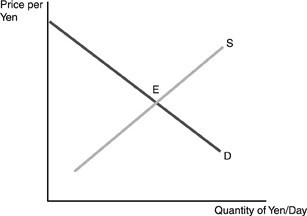 Refer to the above figure. Suppose E is the original equilibrium. Japanese residents have decreased their demand for U.S. goods. This will lead to
Refer to the above figure. Suppose E is the original equilibrium. Japanese residents have decreased their demand for U.S. goods. This will lead to
A. a depreciation of the yen and an increase in the quantity of yens sold per week.
B. a depreciation of the yen and a decrease in the quantity of yens sold per week.
C. an appreciation of the yen and an increase in the quantity of yens sold per week.
D. an appreciation of the yen and a decrease in the quantity of yens sold per week.
Answer: D
You might also like to view...
Which of the following would be considered an example of monetary policy?
A. A broad government initiative to reduce the country's reliance on agriculture and promote high-technology industries. B. A decision by a developing country to reduce government control of the economy and to become more market-oriented. C. A reduction in income tax rates. D. Provision of additional cash to the banking system.
Country A is facing increasing inflation. Country B wants to help Country A but first wants to understand the scale of the problem. Which of the following methods will an economist in Country B use to assess the magnitude of the problem?
a. He or she will calculate the GDP deflator for Country A and compare it with the GDP deflators for countries with known low and moderate inflation rates. b. He or she will calculate the nominal GDP of Country A and compare it with the GDP deflators of countries with known low and moderate inflation rates. c. He or she will calculate the GDP deflator for Country A and compare it with the GDP deflators for other countries in Country A's region. d. He or she will calculate the nominal GDP of Country A and compare it with the nominal GDP of other countries in Country A's region.
Assume the standard trade model with two countries (Alpha and Beta), two goods (food and drink), and two factors of production (land and labor). Further assume that Alpha is relatively labor-abundant and food is relatively land-intensive. According to the Heckscher-Ohlin theory, Alpha has a comparative advantage in the production of
A. both goods. B. neither good. C. drink. D. food.
An increase in quantity demanded of a good is caused by
A) a decrease in income. B) a decrease in the price of a substitute. C) a decrease in the price of the good. D) a change of tastes.